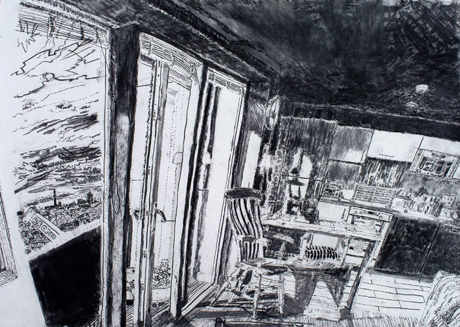Archaeology of Urban Time: Drawing Dalston

Alexandra Blum, 15.4.11 – 17th floor, The Collins’ flat, charcoal on paper, 59 x 84 cm
The urban regeneration which has swept across much of Hackney in recent years has often been the subject of criticism in works by local artists. Change, and the process of change, is rarely viewed positively by creative types, who generally object to the infiltration of large corporations into their cherished community. Yet deep within the bowels of an age-old Hackney institution, the Geffrye Musuem, lies an exhibition which has a refreshing and imaginative take on the ever changing landscape of the borough; in particular, Dalston.
Few areas have witnessed as much of a transformation as Dalston, which has sometimes seemed to resemble a large construction site. When five gigantic cranes were erected at the start of the Dalston Square redevelopment, local artist Alexandra Blum took to sketching these monoliths from street level, mapping the area’s ever-changing skyline, and the evolving relationship between the permanent and the temporary.
Soon after, Blum was appointed ‘artist in residence’ at Dalston Square by developers Barratt Homes, who allowed her to roam freely within the then skeleton structure. “It felt like having my own mountainside to climb in Hackney”, Blum says, and her drawings from this vantage point do indeed have a natural quality; the dulcet charcoal tones render the most mechanical of processes somehow organic.
Blum, a long-term Hackney resident who has lived in various places along Kingsland Road, has an optimistic and philosophical attitude towards regeneration. There is a timeless quality to her deluxe drawings; at first glance, some of the sketches make one think of Dickensian London, and the aesthetic tends to blur the boundaries between the modern day and the distant past. Change is constant, inevitable, and moves in rhythm with everyday life.
The city, like its inhabitants, is in a constant mode of transformation and the construction site represents a microcosm of this universal phenomenon. “The drawings make the passage of time visible”, explains Blum, “revealing the layers beneath the fragile veneer of domesticity”.
Upon the completion of Dalston Square, new residents Ben and Jane Collins were so taken with Blum’s drawings that they invited her into their recently inhabited 17th floor apartment to draw from within the finished structure. The sketches of the Collins’ flat complete the transition from the industrial to the domestic, and it is in these scenes that Blum really excels.
The circle seems complete, and the interior of this fresh space portrays new signs of life and humanity: an urban springtime. The residents themselves are never depicted, and Blum focuses instead on the elements which characterise them as individuals, such as Tony Blair’s biography on the bedside table. Far from eradicating the personal, this once utilitarian edifice has evolved into a cordial, hospitable habitat.
The chaotic, jagged lines with which Blum depicts most of the structures are simultaneously hectic and calm, in keeping with the nature of everyday existence. As Blum dissects the various stages of the development, the drawings start to morph into an ode to the human experience and a life-affirming ethic creeps up upon you, ensuring that you’ll never see Dalston Square in quite the same light again.
Alexandra Blum
Archaeology of Urban Time: Drawing Dalston
Until 27 November 2011
Geffrye Museum
Kingsland Road E2 8EA
